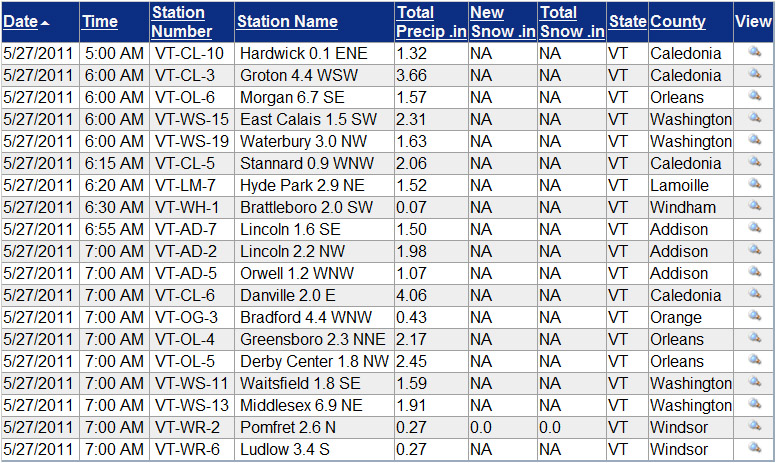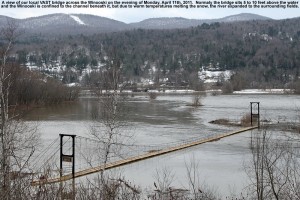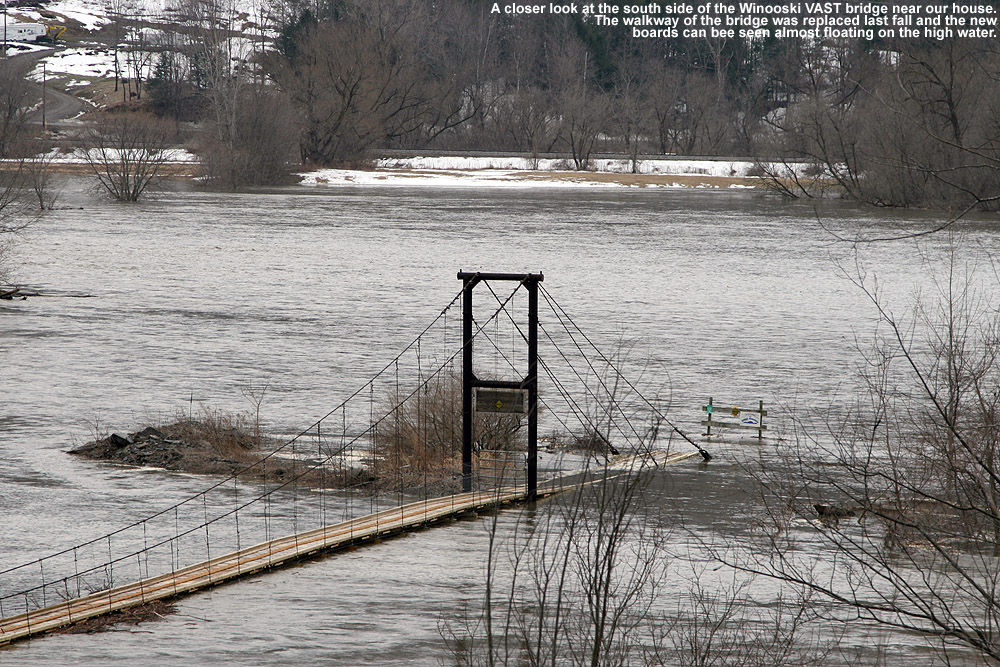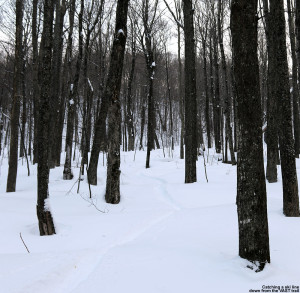
The forecast for today had always been a cold one; earlier in the week it looked like high temperatures were going to be below zero F, even in the valleys. There’s no doubt about it, when the high temperatures don’t reach zero, that’s cold, even by Northern New England standards. When coupled with the vigorous winds from departing Winter Storm Neptune, wind chill values were going to be pushing into the -50 F range in the evening, and that’s just brutal. Fortunately, as the forecast was refined, the anticipated temperatures came up a bit, and the actual temperatures today turned out to reach around 10 F down at the house around midday before they really began to fall in the afternoon. With the forecast, my ski plans for today had always been to head into the protection of the backcountry instead of riding the lifts, and with the combination of temperatures and wind, it looked like there were going to be some “cold holds” for the lifts at the resorts anyway.
“It was easy to see that one could use the trail just like a road with switchbacks on a mountain pass and lap some great lines in that area.”
During my ski tour a couple of weeks ago at the northern end of Bolton Notch, I spoke with a woman who lives in the area, and she said to check out some of the ski terrain above the VAST trail farther south. When I thought about a good access point to the area, the VAST parking area along the Bolton Valley Access Road came to mind. The VAST trail from that point actually goes up and over the pass just north of Stimson Mountain, then drops down and contours along the east wall of the Bolton Notch area. The last time I’d done a ski tour originating from that VAST parking area, I’d quickly left the VAST trail and headed straight up to the ridge, so this would give me the chance to tour the terrain more proximal to the trail itself in Bolton Valley, and then connect right onto the VAST trail on the other side of the ridge to explore the ski options there. I’d also had this ski tour on the list for today because I knew that with the very low temperatures, I’d want something fairly quick and close to home, and this fit the bill.
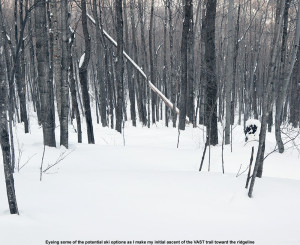
Temperatures had already dropped a few degrees at the house by the time I got on my way up to the Bolton Valley area, and the thermometer was right around the 0 F mark when I pulled into the VAST parking lot. The wind there in the somewhat open surroundings exacerbated the cold temperature, so I got my gear on quickly and headed right onto the VAST trail and into the protection of the trees. After a few minutes I hit the first big turn southward, and since this is where I’d broken off the VAST trail the last time I was there, it was new to me from that point on. I actually wish I’d headed that way sooner than this tour, because there are some nice ski options all around there on the slopes surrounding the VAST trail. It was easy to see that one could use the trail just like a road with switchbacks on a mountain pass and lap some great lines in that area. I noted a number of great areas to drop in as I wound my way up the ascent, and I eventually hit the pass over the ridge line at an elevation of ~1,750′.
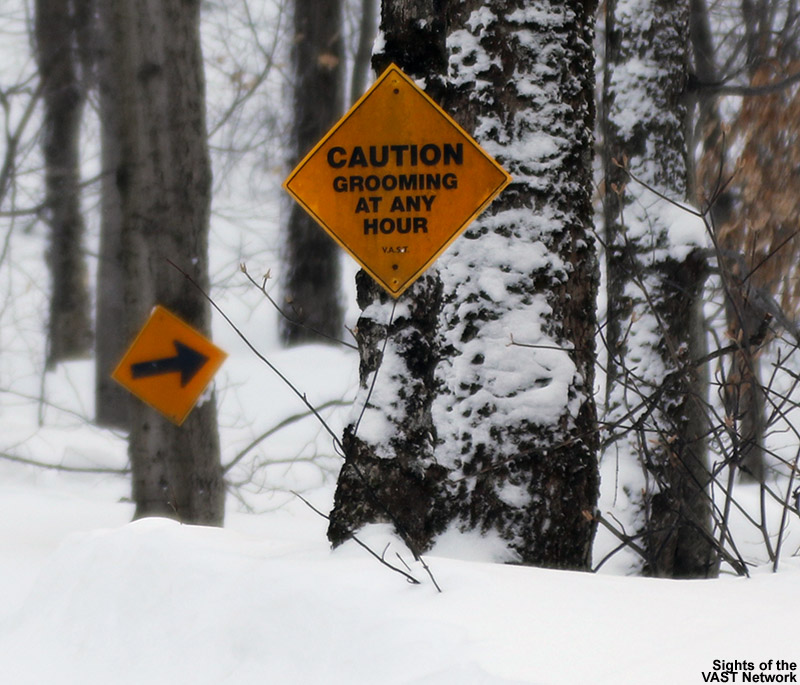
As I broke out of the shelter of the leeward side of the ridgeline, the winds picked right up, probably hitting 20-25 MPH at times. Fortunately that was short lived because I was quickly back down the other side into the shelter of trees. At the pass there’s an obvious height of land just to the south in the direction of Stimson Mountain, and to the north the terrain rises more gradually as the ridgeline gains elevation. I continued on the VAST trail, heading northward, just checking out the potential ski terrain in the surrounding trees and planning to go as far as time would allow. All told I probably covered about a mile or so of distance as I headed northward on that side of the ridgeline. I generally focused on the potential ski terrain above the trail, since that would make for the most convenient setup in terms of finishing at the trail, but I did look at the terrain below as well. The makeup of the forest varied quite a bit along the route, and I assume that depended on the tree composition, and probably more importantly, how old the trees were with respect to the last time the land was logged. There were some nice open areas of trees in the first few minutes north of the pass, although those lines down to the VAST trail itself were relatively short since the trail was just leaving the ridgeline. Beyond that, the next five to ten minutes along the route revealed denser foliage that didn’t seem to offer too many great lines. After that point though, there was another extended section where tree spacing and underbrush looked quite good, and I did see a couple of ski tracks here and there from people that had skied some of the lines. Those lines were definitely longer that those up near the pass, since the VAST trial was a bit lower and the ridgeline had risen. The trees with decent potential went on for a while, but gradually gave way again to denser undergrowth at the stage where I finally turned around to make my way back up to the pass. Throughout my out and back on the west side of the ridge, I hadn’t taken any breaks aside from snapping an occasional photo or GPS tagging a promising line, and the constant movement was definitely a benefit. I was shooting pictures with the 7D2, and definitely appreciating the fact that it’s got the integrated GPS and automatically tags the images locations for future reference. Simply snapping an image and knowing it’s got the exact coordinate embedded is much faster than dealing with the full GPS unit all the time, and that’s appreciated on days like these when you don’t want to stop moving for long. My left toes were just on the verge of getting cold when I was on the generally easier, more downhill travel northward, so it was obvious that I needed to keep the blood pumping.
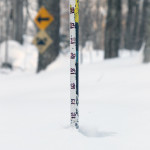 I retraced my way back southward on the VAST trail, and regaining the pass, I continued just a bit down on the leeward side to get out of the wind and then switched over for the final descent back down to the car. I checked the depth of the surface snow and it was over two feet up there, so that bode well for the descent. The air definitely felt like it was getting colder as darkness approached and that northwest wind continued to transport more arctic air into the region, so I stuck with the theme of moving quickly. I’d kept in mind some of the best looking ski lines when I’d made my initial ascent up that east side of the ridge, so I went with turns along the VAST trail itself at first, before finally diving into some open hardwoods off to the skier’s left. The powder was great, with my only complaint being that the skiing was slower than it could have been simply due to the very cold temperatures. I caught back up to the VAST trail at the next switchback, and the mixed up turns on and off the trail from that point downward. I actually saw a group of skiers coming down through one of the very open areas above the final descent to the parking area. It was interesting that I saw them out there, because in all the miles I covered, I didn’t see a single snowmachine. I’m not sure if folks were staying in because of the cold weather, but they definitely weren’t out there on their sleds on that part of the VAST network this afternoon. I had seen one snowmobile trailer in the parking lot when I’d arrived, but it was gone by the time I got back to the car.
I retraced my way back southward on the VAST trail, and regaining the pass, I continued just a bit down on the leeward side to get out of the wind and then switched over for the final descent back down to the car. I checked the depth of the surface snow and it was over two feet up there, so that bode well for the descent. The air definitely felt like it was getting colder as darkness approached and that northwest wind continued to transport more arctic air into the region, so I stuck with the theme of moving quickly. I’d kept in mind some of the best looking ski lines when I’d made my initial ascent up that east side of the ridge, so I went with turns along the VAST trail itself at first, before finally diving into some open hardwoods off to the skier’s left. The powder was great, with my only complaint being that the skiing was slower than it could have been simply due to the very cold temperatures. I caught back up to the VAST trail at the next switchback, and the mixed up turns on and off the trail from that point downward. I actually saw a group of skiers coming down through one of the very open areas above the final descent to the parking area. It was interesting that I saw them out there, because in all the miles I covered, I didn’t see a single snowmachine. I’m not sure if folks were staying in because of the cold weather, but they definitely weren’t out there on their sleds on that part of the VAST network this afternoon. I had seen one snowmobile trailer in the parking lot when I’d arrived, but it was gone by the time I got back to the car.

The wind was picking up and it felt especially cold back at the car; I’m sure the wind chill was well below zero. I started the engine warming while I put away my gear, and got rolling as soon as possible. As much as this cold air has been awesome for powder and general snow preservation, one of these days we’ll be back into some reasonably warm air (like yesterday), and that’s going to be nice. One of these days I’d like to explore terrain in the Bolton Notch area farther to the north near the Long Trail, so that’s on the list for a future trip, but there were definitely some nice ski lines at this southern end as well, and the access is very quick thanks to their proximity to the parking area.












